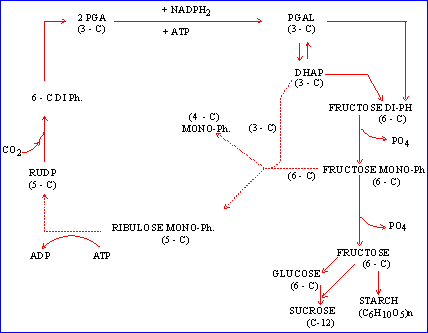|
PinkMonkey Online Study Guide-Biology
4.4 Secondary Processes of Photosynthesis (Biochemical
Phase, Dark Reactions)
The second part or phase-II of photosynthesis is
known as the dark reactions. This is because, the reactions
in this phase do not require light. These reactions are thermo-chemical
and depend on temperature.
The dark reaction involves thermo-chemical reduction
of carbon dioxide to form carbohydrates. This was first established
by Blackmann (1905), hence it is also called Blackmann reaction.
Presence of light is not necessary for the reduction of carbon dioxide.
However, the dark reaction utilizes the products of light reaction
(i.e., the assimilatory power (ATP and NADPH2) to reduce
carbon dioxide into carbohydrates.)
All the reactions in phase-II are completed in
the stroma of the chloroplast. These are biochemical reactions in
which every step is controlled by a specific enzyme. The reactions
begin with the fixation of carbon dioxide, involve the utilization
of the assimilatory power for the reduction of carbon dioxide and
end with the formation of carbohydrate, which is the end product
of photosynthesis.
The details of the steps involved in the dark reaction
(i.e., the complete path of carbon) were worked out by Professor
M. Calvin (who received the 1961 Nobel Prize for the same) and hence,
the dark reaction came to be called as Calvin cycle.
Calvin cycle (C3 pathway)
Important features
(1) This is the major pathway for the fixation
of carbon dioxide in green plants.
(2) It represents phase-II, i.e., the dark
reaction of photosynthesis.
(3) It takes place in the stroma of the chloroplasts.
(4) The reactions are enzyme-controlled and
temperature dependent.
(5) It was discovered by Professor M. Calvin
and therefore called the Calvin cycle.
(6) After the fixation of carbon dioxide, the
first stable compound formed is 3-carbon phosphoglyceric acid (PGA).
Hence it is also called the C3 pathway.
The important events of the Calvin cycle can be
studied under the following heads.
(a) The first CO2 acceptor and fixation
of CO2 : In the Calvin cycle, a 5-C pentose sugar,
ribulose diphosphate (RUDP) acts as the first acceptor of CO2
.
On entering the reactions of the Calvin cycle,
CO2 first combines with 5-C RUDP (fixation of CO2)
to form an unstable and unknown 6-C disphosphate compound. This
compound immediately breaks into 2 molecules of 3-C phosphoglyceric
acid (PGA). The enzyme carboxy dismutase catalyzes the reaction.
Thus, 3-C PGA is the first stable compound formed
in Calvin cycle. Hence, it is also called C-3 pathway.
 Click here to enlarge
Click here to enlarge
Figure 4.6 Diagrammatic representation of Calvin cycle
Regeneration of RuDP is indicated by broken lines
(b) Utilization of assimilatory power (or
reduction of PGA). The 3-C PGA then undergoes reduction with the
help of the assimilatory power to form 3-C phosphoglyceraldehyde
(PGAL). NADPH2 provides the hydrogen and ATP supplies
energy for the reduction. Enzyme triosephosphate dehydrogenase catalyzes
the reaction. Some molecules of PGAL are converted into another
triose phosphate called dihydroxyacetone phosphate (DHAP) in presence
of enzyme triose phosphate isomerase.
(c) Formation of sugars (end products of photosynthesis)
: The 3-C triose phosphates( i.e., PGAL (3-C) and DHAP (3-C))
form 6-C hexose sugar fructose.1, 6 diphosphate in the presence
of enzyme aldolase. Fructose diphosphate is then dephosphorylated
first to fructose mono-phosphate and then to fructose (6-C) in the
presence of enzyme phosphatase. Some fructose monophosphate molecules
may be isomerized into glucose monophosphate by enzyme isomerase
and then into glucose (6-C).
The hexose sugars may be further converted to sucrose
(C12H22O11) or to starch (C6H10O5)n
and stored in storage cells.
(d) Regeneration of the CO2 acceptor, RUDP :
The 5-C RUDP is constantly required for the fixation of CO2
in the Calvin cycle. It is regenerated through another chain of
reactions. Some molecules of triose phosphates and fructose mono
phosphates are used from the Calvin cycle for the formation of RUDP.
|